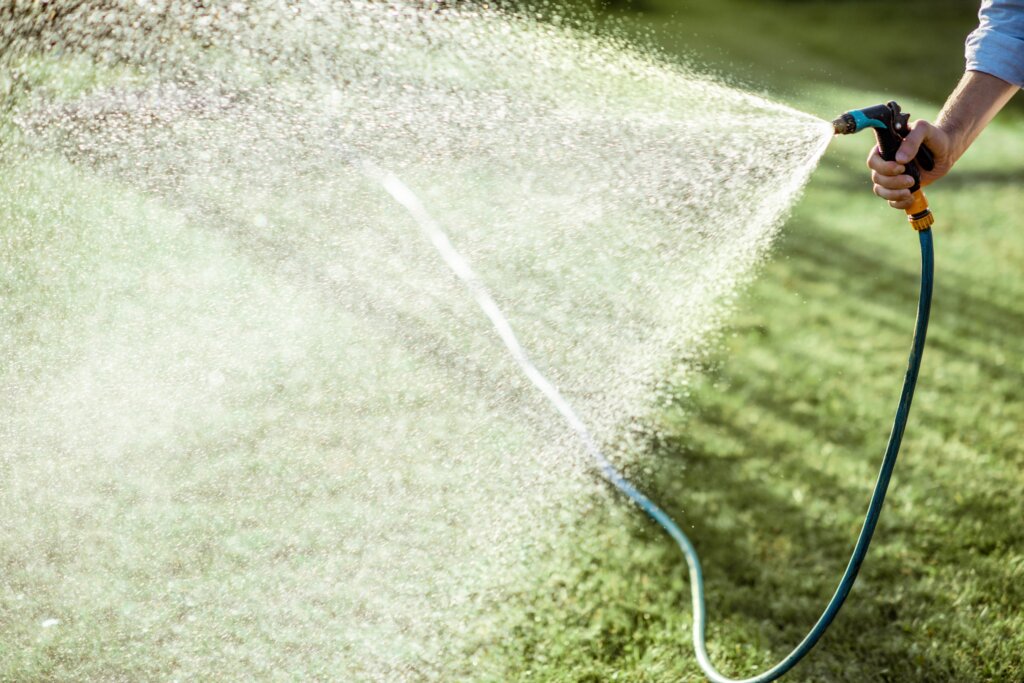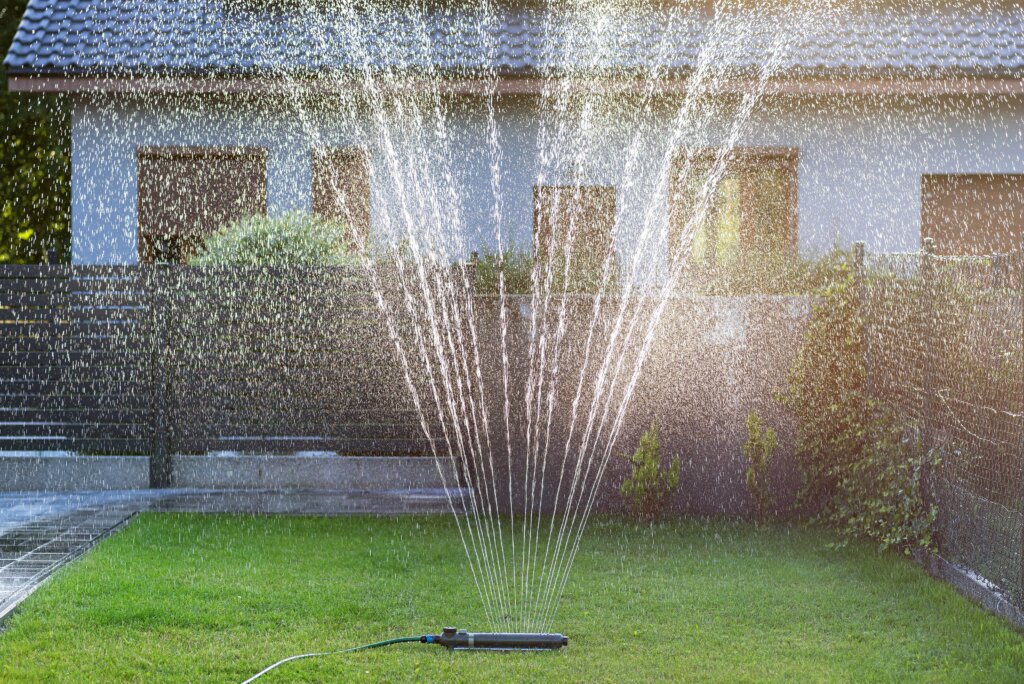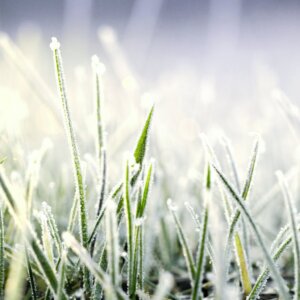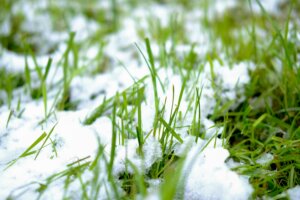Proper watering after fertilizing is crucial for maintaining a healthy lawn. In Pennsylvania, where soil types and weather conditions vary, following the best practices can make a big difference.
According to Penn State Extension, overwatering can lead to nutrient leaching, especially in areas with heavy clay soils. Keep reading to learn exactly when to water after fertilizing for a lush, healthy lawn.
TL;DR: What You Need To Know
- Water granular fertilizers immediately after application; liquid fertilizers can wait 12–24 hours.
- Stick to your consistent watering schedule for a healthy lawn.
- Adjust watering efforts based on grass type, weather conditions, and soil type.
- Proper timing prevents over-fertilizing, nutrient wash-off, and lawn disease.
Understanding When to Water After Fertilizing

Knowing when to water after fertilizing ensures your entire lawn absorbs nutrients efficiently and stays healthy year-round. The timing depends on the type of fertilizer, grass type, and Pennsylvania weather conditions.
Watering too soon or too late can reduce nutrient uptake and lead to disease or nutrient wash-off. For detailed guidance on preparing and applying fertilizer, see our How to Fertilize Lawn guide.
Granular Fertilizer vs. Liquid Fertilizer
Here’s a simple comparison to help you water correctly based on fertilizer type:
| Granular Fertilizer | Liquid Fertilizer |
|---|---|
| Solid particles that need immediate watering to activate nutrients. | Pre-dissolved and penetrates soil naturally. |
| Apply about an inch of water using a sprinkler system or hose for proper absorption. | Wait 12–24 hours before watering; then resume your normal schedule. |
| Avoid excessive watering to prevent nutrient wash-off, especially in heavy clay soils. | Best for cool-season grasses in early spring or early fall during active growth. |
For step-by-step guidance on applying each fertilizer type, check out our Methods of Fertilizer Application guide. Using this comparison, you can easily follow the right watering practices for a healthy lawn and optimal nutrient uptake.
Proper Watering Techniques for Your Lawn

How Much Water to Apply
Stick to your normal watering schedule; no extra water is needed. On average, lawns require about an inch of water per session. Use a rain gauge to track natural rainfall and ensure your entire lawn receives consistent coverage.
Best Time to Water
Watering in the early morning is ideal to reduce evaporation and allow grass blades to dry during the day. Avoid watering at night, which can promote disease and fungal growth.
Using an Irrigation or Sprinkler System
A properly adjusted sprinkler system ensures even coverage across your lawn after fertilizing. Tailor your system for specific grass types: warm-season grasses require less frequent watering than cool-season grasses.
For more detailed guidance on when to water after fertilizing, check out our full guide: Should You Water Your Lawn After Fertilizing?.
Seasonal Lawn Care Tips
Spring and Summer
- Fertilize in late spring for warm-season grasses and early spring for cool-season grasses.
- Water immediately for granular fertilizers; wait 12–24 hours for liquid fertilizers.
- Monitor for high temperatures and adjust watering efforts to avoid drought stress.
Fall
- Fertilizing in early fall supports root growth before winter.
- Maintain proper watering to strengthen your lawn after fertilizing.
For homeowners across the Tri-State area, Terra Lawn Care provides expert seasonal guidance and services to ensure your lawn stays healthy year-round.
Why Watering Your Lawn Matters
Watering after fertilizing ensures nutrients are absorbed into the roots, encouraging:
- Deeper root growth
- Stronger turf resistant to weeds and disease
- Maximized results from your professional lawn care efforts
For PA homeowners, local weather conditions can affect timing. After heavy rain, avoid watering immediately to prevent over-fertilizing and nutrient wash-off.
Professional Lawn Care for a Great Lawn
Terra Lawn Care is a professional lawn care company with over 50 years of combined experience and a 95% customer retention rate. We help your lawn after fertilizing thrive by managing fertilizer application, weed control, and seasonal care for every grass type, including cool-season grasses.
Our team ensures granular products are applied correctly, avoids excess water, and designs efficient irrigation systems so your lawn grows deeper, greener, and healthier. By tailoring treatments to soil, sun, and heat conditions, Terra helps homeowners achieve a great lawn all year long in Pennsylvania with expert fertilization services.
Healthy Lawn Tips for Your Lawn After Fertilizing
Knowing when to water after fertilizing is key to a healthy lawn in Pennsylvania. Following proper watering, selecting the right fertilizer, and adjusting for grass type and soil ensures your lawn, after fertilizing, thrives year-round.
For expert guidance on watering your lawn and tailored fertilization plans, contact our lawn care professionals at Terra Lawn Care. With over 50 years of combined experience, we help keep your yard green and lush through every season.
Frequently Asked Questions About Watering After Fertilizing
The timing depends on the type of lawn fertilizer used. For granular fertilizers, you should water your lawn immediately after spreading so nutrients reach the soil and grass roots.
For liquid fertilizer, it’s usually best to wait 12–24 hours before rain or irrigation to allow the fertilizer application to take effect. Using a reliable irrigation system can help maintain moist conditions without overwatering.
Generally, applying fertilizer to dry grass is recommended. This helps prevent clumping and ensures the nutrients can reach the soil properly.
After spreading, you can water your lawn to help the fertilizer penetrate and feed the plants and grass efficiently. This approach also reduces the risk of nutrients being washed away by excess water.
Absorption varies depending on the fertilizer application, grass type, and soil conditions. Most fertilizers start working within a few hours to a day when followed by proper watering.
Keeping the soil moist and ensuring your lawn receives enough sunlight helps nutrients reach the roots faster. Early summer applications during active growth periods tend to be absorbed more efficiently.
If there’s no rain, your lawn may not get the moisture it needs for proper nutrient uptake. Without water, fertilizer can sit on the grass and fail to reach the roots, reducing effectiveness and potentially causing burn.
Using an irrigation system or manually watering your lawn after fertilizing ensures nutrients are absorbed, promoting a healthy lawn throughout changing seasons. If needed, a lawn care professional can advise on the general rule for timing fertilizer application based on your grass type and soil conditions.



